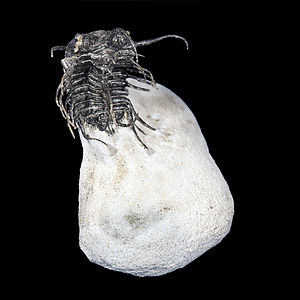Trilobita
Trilobita İngilizce anlamı ve tanımı
Trilobita anlamları
- (n. pl.) An extinct order of arthropods comprising the trilobites.
Trilobita tanım:
Kelime: trilobitatrilobita
Kısaca: Trilobitler (Trilobita), eklembacaklılar (Arthropoda) bölümünün fosil sınıfıdır. ...devamı ☟

Trilobozoa ile karıştırılmamalıdır. Trilobitler (Trilobita), eklembacaklılar (Arthropoda) bölümünün fosil sınıfıdır. Erken Kambriyen'den Geç Permiyen'e...
Kambriyen jeolojik devrini karakterize eder. Filum: Arthropoda Klas: Trilobita Ordo: Redlichiida Subordo: Olenellina Familya: Paradoxidae Genus: Paradoxides...
tarafından üretilmiş olan Trilobite'tır. Yüksek maliyeti (~1399 USD) sebebiyle geniş bir kullanıcı kitlesine ulaşamayan Trilobite'ın üretimi, 2.0 sürümünden...
Oxford University Press, 2019. ^ Gon, S. M. “Trilobite Biostratigraphy.” Edited by Nicolas Tormo, Trilobite Biostratigraphy, 4 Sept. 2018, www.trilobites...
tarihinde Wayback Machine sitesinde arşivlendi. Die Organization der Trilobiten aus ihren lebenden Verwandten entwickelt: nebst einer systematischen Uebersicht...
Bilimsel sınıflandırma Alt şubeler ve Sınıflar Alt şube Trilobitomorpha Trilobita Alt şube Chelicerata Merostomata Arachnida - örümceğimsiler Pantopoda...
Eklem bacaklılar, Eklem bacaklılarDudley, İngiltere Bilimsel sınıflandırma Sınıflar Soyları tükenmiştir Merostomoida Cheloniellida Pseudonostraca Marellomorpha Arttıropleurida Trilobita...
Trilobitomorpha, Taksokutu, Animalia, Arthropod, Arthropoda, Bilimsel sınıflandırma, Kambriyen, Sınıf, TrilobitaBilimsel sınıflandırma Alt şubeler ve Sınıflar Alt şube Trilobitomorpha Trilobita Alt şube Chelicerata Merostomata Arachnida - örümceğimsiler Pantopoda...